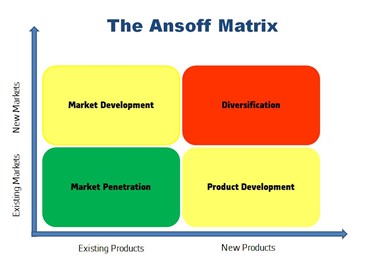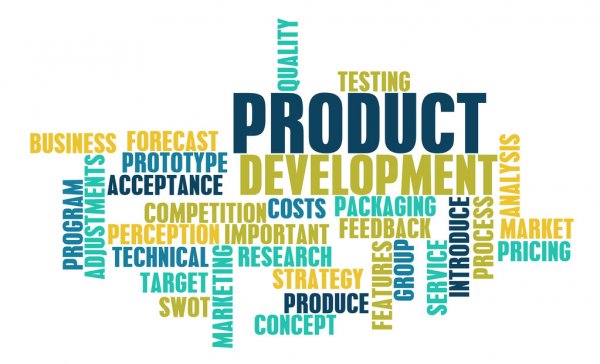Difficult times often require rethinking a company’s products and markets to maintain or grow revenue. These last months have certainly been a time for owners to review their business model and product strategy. Many markets have shifted or disappeared entirely. Products that worked yesterday may be obsolete tomorrow.
Merely being the best or lowest cost of producing a product that the market moves away from will not help grow revenue. Therefore, businesses must seek to maintain and increase their product revenues by applying several product and market strategies.
In the 1950s, Igor Ansoff1 came up with a new market strategy matrix based on two factors: Product and Market. Simply put, you can improve or change the product or go after new markets, or both. A simple illustration of Ansoff’s Product / Market Matrix is shown here. Each strategy carries a varying amount of risk, based on how many changes and how much the change.

According to Ansoff’s matrix, a company can choose to take several alternatives with increasing risk but potentially increasing returns. The matrix allows a company strategist to evaluate the options for growing sales revenue.
The first and least risky approach is to obtain deeper market penetration with existing products within existing markets. Higher market share can be achieved through increasing awareness, price reductions, and sales incentives. Another approach is to evaluate selling an existing product into a ‘new market.’
New markets can be new geographic markets or find alternative uses for the product in markets other than the primary market. Think of the traditional marketing of baking soda as an odor absorbent in refrigerators.
Finding alternative or subsequent uses for a product can sometimes out-perform the original market the product was intended for. Deep insight into how existing customers are using a product can often identify these potential market expansions.
When considering new ‘products,’ one must be careful to do appropriate due diligence on the market and the competition before making large product development investments. The easiest way to develop a ‘new product’ is to significantly change or improve an existing product in such a way as to out-perform the other competitors in the current market. This product enhancement often has limited duration if the competition can also add features or match performance without violating patents or proprietary designs. Another twist on this approach involves redesigning a product to reduce its material or labor cost significantly. While it may not increase sales volume or revenue, this approach can benefit a company through higher gross margins and net profits.
Lastly, developing a new product based on company strengths and capabilities can allow the company to continue to grow and expand. What core competencies does the company possess? How can these core competences be leveraged into new products?
What market intelligence do you have that would give insight into the opportunities? Product Development can be a significant investment; however, it can also reap growth and potentially extend a company’s life. Disciplined product development starts with accurate market information on what the product needs to do, who would potentially be the customer and end-user, any alternatives that might exist, or development.

Once it is determined that a potential market exists, key product characteristics and features should be defined. Many market research firms provide information on potential market growth.
However, this market information can sometimes be misleading or inaccurate. A prudent next step is to validate the market. This can be done in several ways. One popular method is to define a ‘Minimum Viable Product,’ or MVP, and find a way to ‘test’ the market. This could be a conceptual product brochure, a virtual product that potential customers can interact with, or an actual physical prototype. This step is often overlooked in many product development efforts. This step’s importance is to make sure that 1) the market exists and 2) that your product concept meets the market need. Before companies spend large amounts of money developing a product that no one wants, they must test the market.
If there is some validated market need, these early MVPs can refine the essential product features. In Eric Ries’ book The Lean Startup2, he states that successful product development companies master the ‘design-measure-learn’ feedback loop.
This concept is a repetitive process of building or designing something, measuring how it operates (in the market, for instance), and learning from the feedback to modify the design and go back through the process. This product development method ensures that the right product is developed to meet the real market need. The converse of this approach is to spend large amounts of time and money and design the perfect product that no one will buy. Many an entrepreneur has fallen into this trap.
By far, the riskiest approach is to develop a new product for a new market. In this case, little data exists on the potential market or what a product might do to capture it. History is full of recent product / new market successes such as online auctions, secure web payments, and handheld digital music devices. These new product developments are not for the faint of heart and often require significant research and development resources that most small and medium businesses don’t have. However, innovative companies create these new products launched into new markets every day. The wisdom here is to know what it will take and balance it against the potential return.
These are a few of the options for revenue growth through product development and launching products into markets. The most important take-away is to evaluate the product and market strategy before going down a path. Know the risks and potential returns. Evaluate what makes your company what it is. What are you good at? What do you see lacking in the market? New product development can be an exciting and invigorating process if done correctly.
It can ensure the longevity and success of a company, or it can bankrupt it. Know yourself, know your markets and make a conscious decision to pursue the strategy that suits your unique situation. Dream big and good luck!
Cogent Analytics exists to help small and medium-sized privately held business reach their goals. This is accomplished through establishing partnerships to build, implement, train and evaluate systems, processes, people, and organizations that create value for owners. We achieve this through coming alongside companies to provide Profit Engineering, Organizational Engineering, Process Engineering, and wealth creation for its owners.



